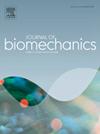Age-Related changes in joint power during gait: Adaptations in middle-aged adults to maintain walking speed
IF 2.4
3区 医学
Q3 BIOPHYSICS
引用次数: 0
Abstract
Across the adult lifespan, gait speed is thought to be maintained through midlife and starts to decrease after age 60. Reducing the piston-like drive of the gastrocnemius during push-off (ankle joint power burst A2) is a change that decreases gait speed and increases stability in older adults. As physiological systems begin to decline during midlife, middle-aged adults may adjust their joint powers to minimize destabilization while maintaining a gait speed comparable to that of younger adults. The purpose is to quantify changes in joint powers during gait as a function of advancing age; younger (ages 20–35), middle-aged (ages 50–64), and older adults (ages 65–79). Participants walked at their self-selected speed, for ten trials, along a 15 m walkway. Joint powers for the hip, knee, and ankle were calculated. Older adults walked slower (1.33 m/s) than the younger and middle-aged groups (1.44 and 1.44 m/s, respectively). Middle-aged and older adults had lower ankle energy generation (A2) than younger adults. Middle-aged adults had lower ankle energy absorption (A1) than the other two age groups. Lower A2 reduces the piston-like push-off during late stance presumably to reduce the associated instability. However, the reduced energy generation did not decrease speed in middle-aged adults because energy absorption was reduced during mid-stance (A1). The reduced absorption allowed the body to rotate forward over the ankle faster and maintain gait speed despite reduced energy generation during push-off. Thus, middle-aged adults flexibly adapted both energy generation and absorption to maintain gait speed, a novel finding.
在成年人的整个生命周期中,步态速度被认为会在中年时期保持不变,并在 60 岁之后开始下降。减少腓肠肌在推起时的活塞式驱动力(踝关节爆发力 A2)是老年人降低步速和增加稳定性的一个变化。随着中年生理系统开始衰退,中年人可能会调整关节力量,以尽量减少不稳定性,同时保持与年轻人相当的步速。这项研究的目的是量化步态过程中关节力量的变化与年龄增长的关系,包括年轻人(20-35 岁)、中年人(50-64 岁)和老年人(65-79 岁)。参与者以自己选择的速度在 15 米长的人行道上行走 10 次。计算髋关节、膝关节和踝关节的关节力。老年人的行走速度(1.33 米/秒)低于年轻组和中年组(分别为 1.44 米/秒和 1.44 米/秒)。中年人和老年人的踝关节能量生成(A2)低于年轻人。中年人的踝关节能量吸收(A1)低于其他两个年龄组。较低的 A2 可以减少晚期站立时的活塞式推举,从而降低相关的不稳定性。然而,能量产生的减少并没有降低中年人的速度,因为中段站立时能量吸收减少(A1)。尽管推起时的能量产生减少,但减少的能量吸收使身体在踝关节上向前旋转的速度更快,并保持步态速度。因此,中年人灵活地调整能量产生和吸收以保持步速,这是一项新发现。
本文章由计算机程序翻译,如有差异,请以英文原文为准。
求助全文
约1分钟内获得全文
求助全文
来源期刊

Journal of biomechanics
生物-工程:生物医学
CiteScore
5.10
自引率
4.20%
发文量
345
审稿时长
1 months
期刊介绍:
The Journal of Biomechanics publishes reports of original and substantial findings using the principles of mechanics to explore biological problems. Analytical, as well as experimental papers may be submitted, and the journal accepts original articles, surveys and perspective articles (usually by Editorial invitation only), book reviews and letters to the Editor. The criteria for acceptance of manuscripts include excellence, novelty, significance, clarity, conciseness and interest to the readership.
Papers published in the journal may cover a wide range of topics in biomechanics, including, but not limited to:
-Fundamental Topics - Biomechanics of the musculoskeletal, cardiovascular, and respiratory systems, mechanics of hard and soft tissues, biofluid mechanics, mechanics of prostheses and implant-tissue interfaces, mechanics of cells.
-Cardiovascular and Respiratory Biomechanics - Mechanics of blood-flow, air-flow, mechanics of the soft tissues, flow-tissue or flow-prosthesis interactions.
-Cell Biomechanics - Biomechanic analyses of cells, membranes and sub-cellular structures; the relationship of the mechanical environment to cell and tissue response.
-Dental Biomechanics - Design and analysis of dental tissues and prostheses, mechanics of chewing.
-Functional Tissue Engineering - The role of biomechanical factors in engineered tissue replacements and regenerative medicine.
-Injury Biomechanics - Mechanics of impact and trauma, dynamics of man-machine interaction.
-Molecular Biomechanics - Mechanical analyses of biomolecules.
-Orthopedic Biomechanics - Mechanics of fracture and fracture fixation, mechanics of implants and implant fixation, mechanics of bones and joints, wear of natural and artificial joints.
-Rehabilitation Biomechanics - Analyses of gait, mechanics of prosthetics and orthotics.
-Sports Biomechanics - Mechanical analyses of sports performance.
 求助内容:
求助内容: 应助结果提醒方式:
应助结果提醒方式:


